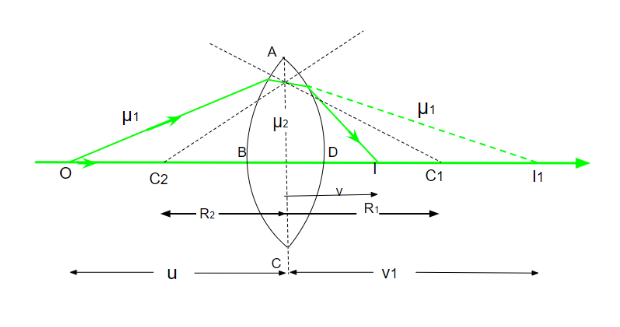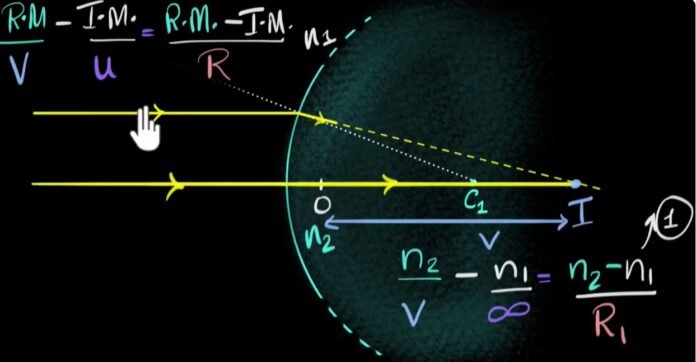The Lens Maker Formula is a mathematical expression that describes the relationship between the properties of a lens, such as its curvatures, refractive index, and focal length. It is a crucial tool used in optics and lens design to determine the size, shape, and material of lenses required to form a specific image. The formula is based on the principles of optics, which describe the way that light travels through a lens.
The Lens Maker Formula is used in a variety of fields, including photography, microscopy, telescopes, and eyeglasses, and is critical for students and professionals in the field of optics and lens design. Understanding and applying the Lens Maker Formula helps in the manufacture of lenses and ensures their precision and accuracy.
Assumptions
Let us consider the thin lens in the image above that has two refracting surfaces with the corresponding radii of curvature, and respectively.
Let and be the relative refractive indices of the surroundings and the lens material.
Derivation
The Lens Maker’s formula is used to calculate the radius of curvature of a lens. It relates the focal length of a lens to its refractive index and the radii of curvature of its two surfaces. The formula is derived by considering the laws of refraction of light at the two spherical surfaces of a thin lens.

Let “u” be the distance of an object from the lens, “v” be the distance of the image from the lens, “f” be the focal length of the lens, and be the refractive indices of the materials on either side of the lens and and be the radii of curvature of the two surfaces of the lens. The center of curvature of the first surface is and the center of curvature of the second surface is .
We begin by assuming an object is placed at a distance u from the lens. The first refraction takes place at the first spherical surface and forms an intermediate image at a distance . The second refraction takes place at the second spherical surface and forms the final image at a distance v.
Using the formula for refraction at a single spherical surface, the equation for the first refraction can be written as:
Similarly, the equation for the second refraction can be written as:
Adding these two equations, we get:
When the object is far away from the lens, the image is formed close to the focus. Thus, for u = ∞ and v = f, the lens maker formula is derived as:
Also, the relationship between the object distance “u”, the image distance “v”, and the focal length “f” of a lens is given by the lens formula:
Therefore we can write as:
This expression is the lens maker formula and is used to determine the focal length of a lens given the radii of curvature of its two spherical surfaces and the refractive indices of the media on either side of the lens.
Applications of the Lens Maker Formula
- The Lens Maker Formula is used in a variety of fields, including photography, microscopy, telescopes, and eyeglasses
- It helps in the design and optimization of lenses for specific image formation requirements
- The formula is also used in the manufacture of lenses to ensure their precision and accuracy
Limitations of the lens maker’s formula
- The formula assumes that the lens is thin, spherical, and has a uniform refractive index, which may not always be accurate in real-world situations.
- The formula only considers the curvatures of the lens, its refractive index, and its focal length, and does not take into account other important factors such as the thickness of the lens, its material, or the position of the object being imaged.
- The formula is not applicable to lenses that are not spherical or that cannot be approximated as spherical.
- The formula assumes that the object being imaged is located at infinity, and does not consider the effect of multiple objects at different distances.
Recommended Articles:
Hall Effect: Introduction, Theory, Principle, Principle, And Applications
Heat Equation: Introduction, Assumptions, Derivation, And Applications
Derivation of Kinetic Energy
Derivation Of Law Of Conservation Of Momentum
Derivation Of Lens Formula
A lens is a transparent object that refracts light to form an image. The relationship between the curvatures of a lens and its focal length is described by the Lens Maker Formula. The curvatures of a lens determine the way it refracts light, which in turn affects the position and size of the image it forms. Yes, the Lens Maker Formula can be used for both convex and concave lenses. The Lens Maker Formula is a specific formula that relates the curvatures of a lens, its refractive index, and its focal length. Other lens design formulas may consider additional parameters such as the thickness of the lens, its material, and the position of the object being imaged. The Lens Maker Formula is used in a variety of fields including photography, microscopy, telescopes,and eyeglasses to design lenses with specific image formation requirements. Derivation Of Lens Maker Formula FAQs
What is a lens?
What is the relationship between the curvatures of a lens and its focal length?
Can the Lens Maker Formula be used for both convex and concave lenses?
What is the difference between the Lens Maker Formula and other lens design formulas?
What are the real-world applications of the Lens Maker Formula?
